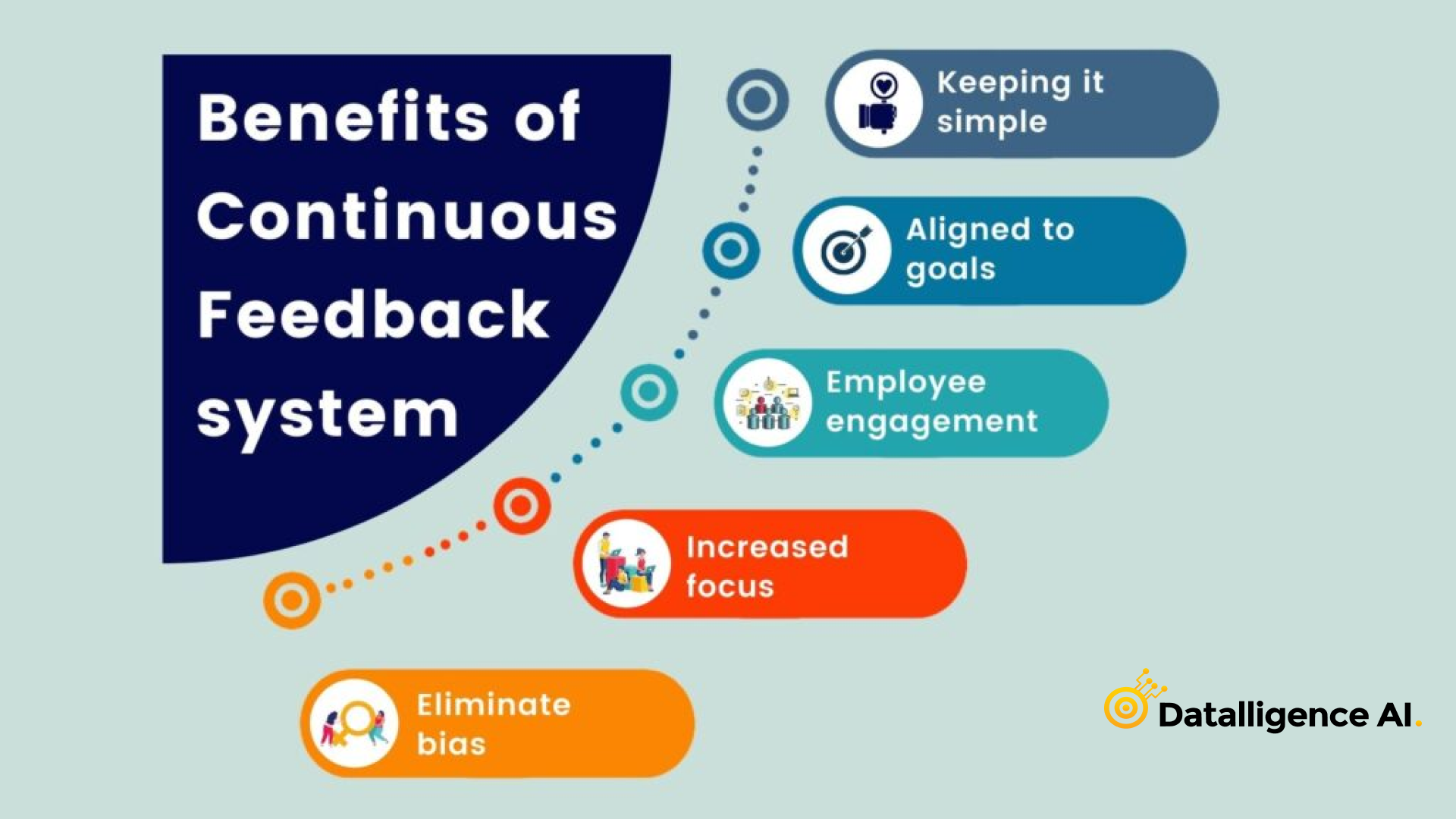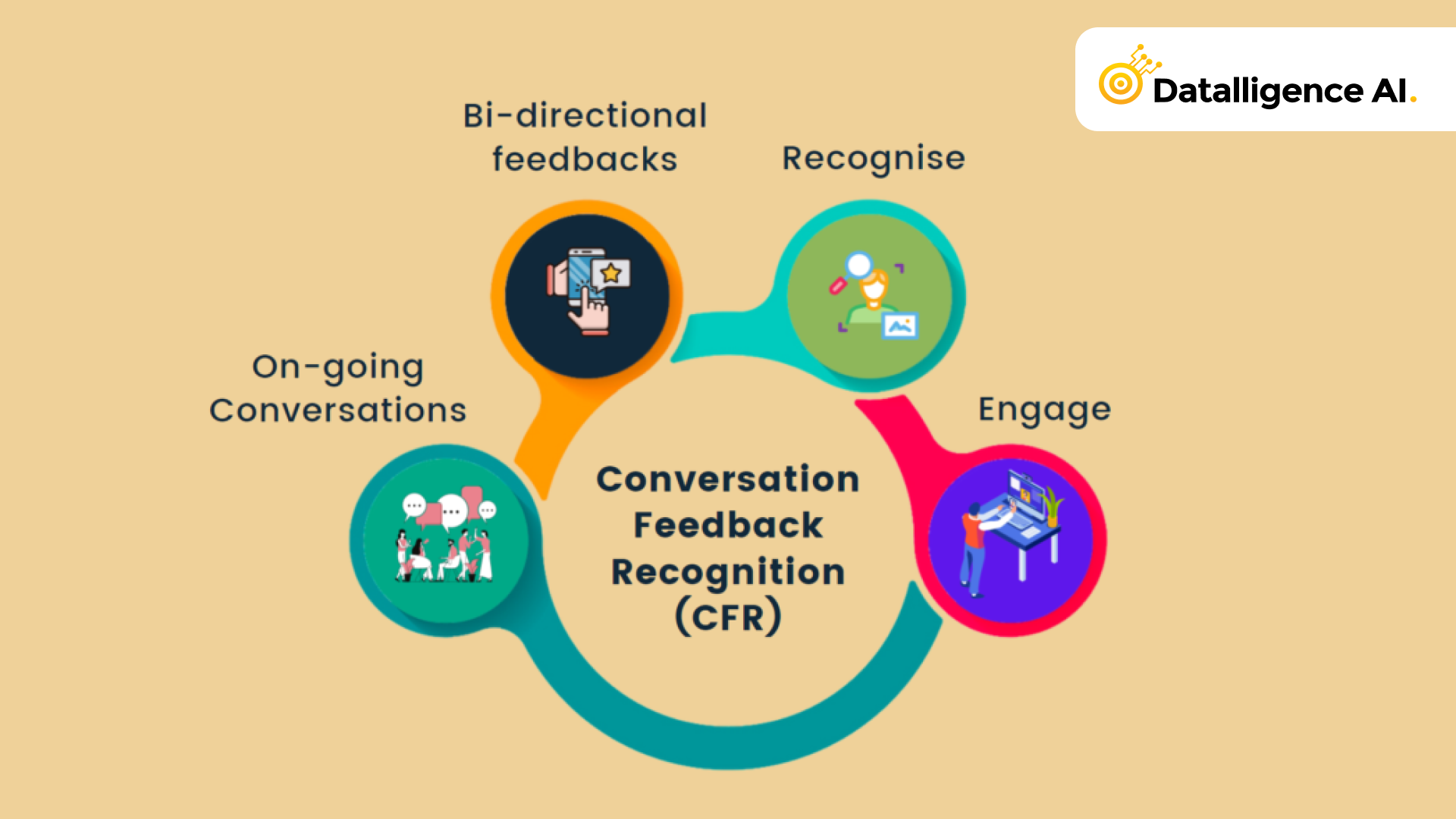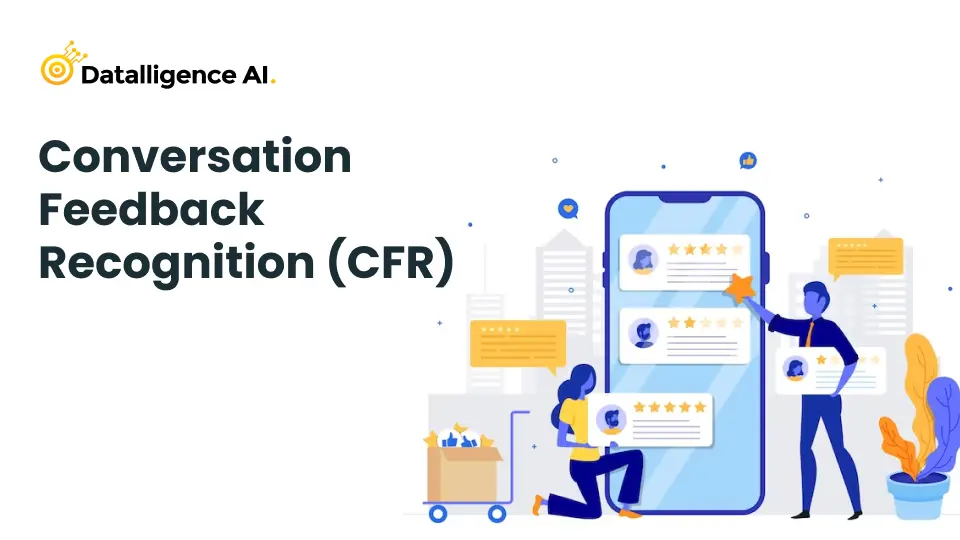Do you know that millennials require more feedback than do other generations? The fact is, managers aren’t providing the feedback millennials want, according to Gallup’s latest report, How Millennials Want to Work and Live.
Objectives are very significant and are action-driven. Key results are quantifiable and specific. Conversation, Feedback, and Recognition (CFR), on the other hand, are the result of public, transparent OKRs
CFRs should be an ongoing process and should be happening in the entire OKR cycle and 1:1s are highly essential at the end of each cycle. These conversations should reflect in goal-setting and ongoing progress updates. Feedback should be specific and constructive allowing the employee to interact and share feedback with their supervisors.
Few questions to ask for Conversation and Feedback?
- How are the OKRs coming along?
- Are there enough resources as planned for the committed OKRs
- Is our Aspirational OKR is as per the plan?
- What critical capabilities do you need to be successful?
- What could be the roadblock in attaining the objectives?
- What OKRs need to be adjusted—or added, or eliminated, or is there a change in the priorities?
Table of Contents
What is Continuous Feedback? The Definition
As the name suggests, continuous feedback refers to any kind of feedback that is conveyed periodically. Ideally in the corporate world, this feedback mechanism should run like clockwork.
On the surface, the continuous feedback system creates a habit for discussion for issues, ideas as well as reviews. It also makes room for constructive criticism and the growth of the employees. Hence, organizations need to adopt the culture of Continuous feedback.
Continuous Performance Management
A major chunk of the continuous feedback system goes to performance management. But what exactly are we looking at here?
In an organizational environment, Continuous performance management is an ongoing process that takes place in the company throughout the year where feedback and insights are shared. The strengths and weaknesses of the employee are analyzed. Contrary to the traditional system of annual performance reviews often attached with appraisals, this culture is much more holistic and goal-driven as it happens around the clock. To add to that, this system creates a healthy relationship between the employees and the manager which automatically makes the workplace productive and motivating.
Continuous Feedback System Model

At the outset continuous feedback system as the name implies has no target date given to give or take feedback, the feedback happens naturally and continuously. This helps teams or individuals discuss their issues, concerns, and ideas openly. An effective continuous feedback system will enable a healthy discussion between the manager and the peers.
Also, it helps individuals to capture and analyze their strengths and weakness. We get to understand an individual beyond his role, what are her/his passion, hobbies, and what motivates him/her. This helps in giving support to the team member or their peers. We get to exchange ideas keep the motivation on for the long term.
The most important aspect is that it enables both upward and downward feedback. This allows an employee to talk his mind to the manager and vice-versa. This will help each other in developing their skills and improve their attitude and confidence.
Let us investigate the “Deming wheel”, a concept developed by Dr. W. Edwards Deming, an eminent Management Consultant in the 1950s.
It is a model based on the fundamentals of Continuous Feedback and helps you implement the same successfully. This Plan-Do-Check-Act model helps define ongoing feedback, its benefits, and how it can be carried out in workplaces.
Now, let us study what these terms represent.
PLAN
The first step towards achieving our goal is to detect and understand the problem areas. Once you have climbed this step, the next is to plan your feedback delivery. Always remember, feedback should purely be statistically driven and factually correct.
DO
After planning out the solutions, the next obvious step is to implement them. However, it is advised to implement these solutions on a smaller scale first before striving for the whole organization, almost like a test run. This gives you an idea of the kind of changes that will be seen while ensuring minimum disturbance.
CHECK
This step is to analyze your test run. If it runs smoothly and matches your expectations, take it as a green signal to shoot the works. Otherwise, identify the issues and make necessary improvements before the implementation on a larger scale.
ACT
The final step is to implement all your solutions. Keep in mind that this is a continuous feedback loop and not a straightaway, sporadic process. You can always bend and improvise on these solutions whenever required.
Ongoing Feedback Definition
Ongoing feedback can be defined as consistent feedback exchanged between the manager and the employee that instigates discussions based on company/employee goals, problem areas as well as areas of improvement.
Moreover, Ongoing feedback on performance refers to inputs given to employees specifically regarding their performance in the organization.
Concept of CFR Continuous Feedback

It is also an industry practice that performance appraisal and feedback are tied together and have the tag “Yearly” attached to it. This process ends up with higher employee turnover. All those matured and developing organizations that have adopted the concept of continuous feedback through conversation at regular intervals, reap the fruits of this investment. In fact, most organizations have also begun appreciating instantly when an employee does the job exceedingly well.
This level of maturity to appreciate and course-correct in a timely fashion presents us with many benefits. A few benefits of continuous feedback are:
• Better employee engagement
• Less employee turnover
• Cost-efficient Human capital management
• Healthy superior-subordinate relationships
We are in the process of stitching these three interdependent concepts and the organizations need to have equal focus on all these 3 aspects
1. Healthy conversations
Allows conversational feedback discussions and there is less room for ambiguity in understanding the benefits of goals for both – the employee and the manager
2. Two-way Feedback
Timely and regular feedback allows rectifying the path earlier as required thus making goals achievable. It also allows the employee to give his/her feedback to the manager. This in turn is an opportunity for the managers to course-correct themselves and orchestrate the overall goals within the team.
3. Recognize/Appreciate
The word feedback is understood as a course correction tool however the fact is – it has to be a sandwich of all work done well by the employee and then those areas of improvement. This concept of appreciation is always overlooked in most organizations. This act requires course correction by way of appreciating good work immediately to keep the momentum of the work overall and boost the morale of the employee to do better.
The employees feel engaged and learn to take accountability when appreciated because they feel the onus is on them to drive the task towards completion.
While stitching all these 3 concepts, we also need to avoid any form of favoritism/biases that could be prevalent and hence a tool that drives these initiatives quantitatively is the need of the hour. The virtual being has made employees’ achievements visibility even more challenging. The managers have to constantly announce the work of their team. In the current scenario, as employee appreciation is left unnoticed, this has resulted in performers’ turnover being higher in the past year.
In a nutshell, it is difficult to retain talent if not handled with care. These three concepts do focus on giving that care to the employees. When the human capital is managed well, the overall organization goals are achieved with less or no turmoil. This process has to constantly improve itself and mature which is a journey and it should not be treated as a one-time task or a job.
Efficient Ways To Adopt The Continuous Feedback Performance Management Strategy
Since we are familiar with the definition of ongoing feedback performance management, we shall examine ways to develop meaningful strategies.
Here are certain points to remember while implementing continuous performance management:
It should be a simple and amicable process
Forbes’s statistics show that although most employees consider feedback important, only less than 1/3rd of them acquire it. A continuous feedback system is a healthy and productive culture adopted by the organization. Hence, it needs to be conducted in such a way that employees as well as the managers look forward to it and constantly grow through it.
Systematic and scheduled feedback
Make regular, timely schedules to deliver feedback rather than letting it bottle up. When this situation arises, the feedbacks tend to be summarized and overviewed. Consequently, when feedbacks are frequent, it lets you give structured and detailed comments. This also helps make the process motivating and less scary.
Neutral and unbiased feedback
As we already came across; feedback should be based on facts and statistics. Building them on the grounds of gender, personal grudges, ethnicity, etc. is extremely unprofessional and needs to be avoided at all costs.
Upward and downward feedback
Contrary to popular belief, feedbacks are not a linear process. It is an ongoing loop and goes both ways. To be more precise, the manager gives feedback to the employee and vice-versa. This enforces a healthy and encouraging environment. Managers become much more efficient in their jobs and become super managers.
How Does Continuous Feedback Impact My Organization?
Practicing a culture of ongoing feedback has vast effects on an organization. In an environment like such, employees tend to trust and support each other. The continuous feedback loop boosts employee engagement.
According to Aon Hewitt, an outsourcing company based in The United States, Employee engagement is “the level of an employee’s psychological investment in their organization.”
This system increases the employee’s alignment with the organization which allows the company to grow unanimously.
When employees are aware of what is expected of them, they make prompt contributions to the company.
360-degree feedback ensures soaring growth for employees and is said to have a positive impact on the retention rate of employees. At the same time, there is said to be a decrease in employee turnover.
Benefits of Continuous Performance Management
So far, we have looked at the meaning of continuous performance management, the importance of continuous feedback, and ways through which this culture can be adopted in an organization.
Now here are a few concrete benefits that any organization will celebrate once the practice of Continuous performance management is successfully followed.
1. Negligible Skill Gaps
Productivity issues, weaknesses, lack of focus, or any sort of obstacle are instantly addressed and overcome when feedbacks are given regularly.
2. Healthy Interactions
When feedback is exchanged consistently and constructively, the whole organization will be built with mutual respect and understanding which in turn boosts productivity and maintains a smooth road towards the company’s goals.
3. Enhanced Focus
Since the system is based on frequent feedback sessions rather than an annual performance review, it not only avoids employees from dwelling upon mistakes but paves the way for future successes. This way, employees have a clear vision in mind to accomplish their goals in a timely fashion.
4. Provides Comprehensive Input
A constant give and take of feedback allow the feedback to be specific and detail-oriented and helps tackle distinct hindrances at every step. Moreover, it helps understand the potential and effectiveness of each employee and identifies any unbalanced flow of efficiency if present.
Continuous Feedback: Examples & Use Cases
Why does my company need continuous feedback? To rightly answer this question, we shall take a few examples and study them.
Renowned companies like Netflix, Adobe, and Google to name a few have successfully implemented the continuous feedback system and are thriving today. Here are the steps they took on and how continuous feedback benefits their organization.
Adobe style of continuous feedback
Adobe religiously practices quarterly delivery of feedback where each session lasts about 60 minutes or longer. In addition to this, they also believe in informal feedback sessions to enhance professional relationships.
They have a check-in toolkit that allows one to design their strategies. The toolkit is based on setting up expectations, giving feedback, and implementing said feedback in your work.
This helps one focus on strengths and timely accomplishment of goals while maintaining quality.
After months of planning and several tests runs later, Adobe now has one of the most successful feedback cultures in the corporate world.
Netflix’s feedback culture
Netflix staunchly encourages individuality among employees.
They also emphasize informal feedback sessions as it allows to create a candid and un-filtered work environment.
After Implementing this culture, Netflix employees enjoyed an enhancement in creative thinking, team connectedness, problem-solving skills, etc.
Employees are also encouraged to express every thought or idea they possess. This freedom of expression increases transparency and builds a strong communicative environment.
Cargill’s everyday performance management system-
Cargill, a private global food corporation based in Minnetonka, Minnesota enjoys employee satisfaction and engagement today credits to everyday performance management which includes daily spontaneous conversations between the employee and the manager.
Initially struggling with a lack of motivation and focus among employees, this new practice has successfully boosted productivity and helped build a motivating, healthy workspace.
Who Needs To Be Involved In The Continuous Feedback System?
The key to a fruitful continuous feedback system is to always bear in mind the fact that feedbacks are a two-way transaction. Every single person in the organization should play an active part in both giving as well as receiving feedback and not just the manager.
At the same time, it is also important that you “request” feedback based on your performance on a particular work or just the work itself and not wait until it is your turn for a feedback session. Both positive and negative feedback should be given then and there otherwise it might lose its impact. Such frequent and short reviews when given in context help personal growth and establish a practice of “often yet minimal.”
When these sessions happen in a flowy, light-hearted style, it leads to towering performance management and continuous improvement within an organization.
Conclusion
The process of conversation, feedback, and recognition (CFR) has to evolve and the organization’s growth. The levers of this process should be connected to the goals of the organization to keep the journey less grumpy.
Datalligence strongly believes in continuous feedback management, the CFR (Conversation, Feedback & Recognition) module enables users to recognize the team instantly. The ongoing conversations and the feedback on the platform enables employee engagement and improve productivity and motivation.
Our product is developed with foresight that it will eradicate or reduce the task-based approach in feedback rather than have the human touch besides being quantitative.










